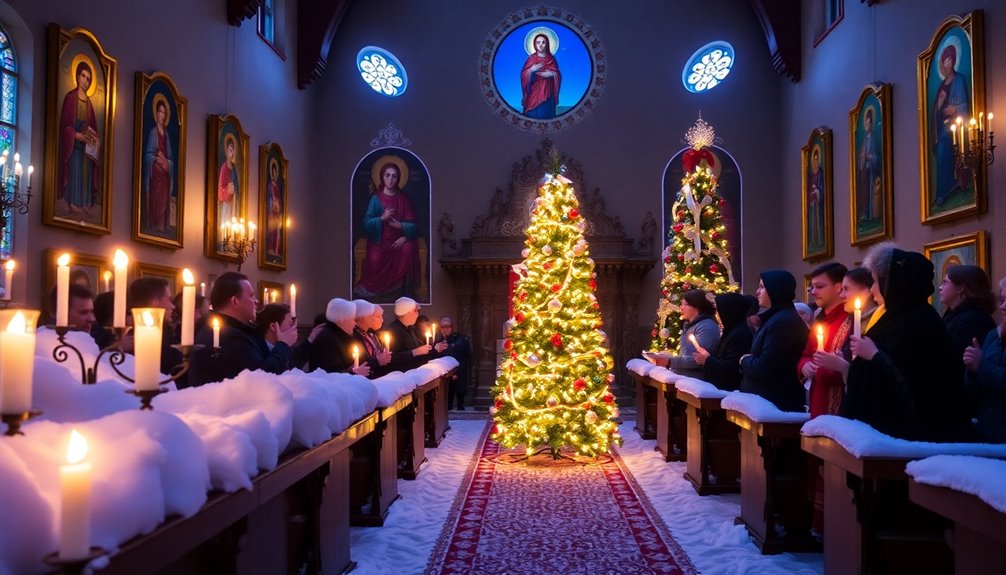The Orthodox Church celebrates Christmas on January 7 because it follows the Julian calendar, which is 13 days behind the Gregorian calendar used by most of the world. This difference dates back to the Great Schism of 1054 when Orthodox Christians rejected the Gregorian calendar, choosing to preserve their traditional practices. Many communities honor this date with significant customs, including a 40-day fasting period and festive meals. The celebration is deeply rooted in cultural identity, offering a sense of belonging. If you're curious about the unique traditions and practices surrounding this holiday, there's much more to explore.
Key Takeaways
- The Orthodox Church uses the Julian calendar, which is currently 13 days behind the Gregorian calendar, leading to January 7 celebrations.
- The Julian calendar was adopted in 46 BC, while the Gregorian calendar was introduced in 1582 to correct calendar discrepancies.
- Many Orthodox communities still follow the Julian calendar due to historical and theological reasons stemming from the Great Schism of 1054.
- A 1923 conference led to some Orthodox churches adopting the Revised Julian calendar, but many continue to observe Christmas on January 7.
- Cultural identity and traditional observances play significant roles in maintaining January 7 as the date for Christmas celebrations within Orthodox communities.
Historical Context of Calendar Differences
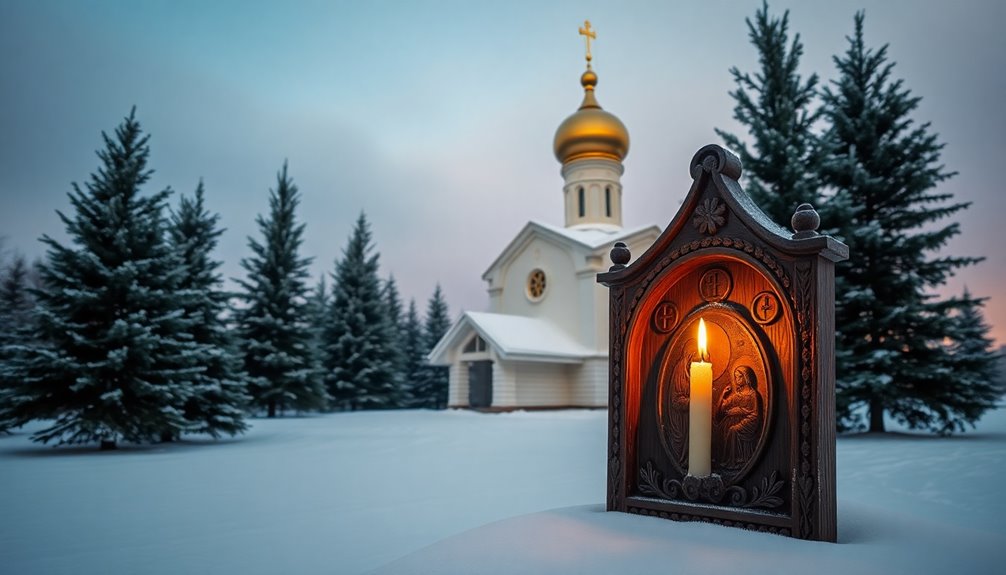
When you explore the historical context of calendar differences, you'll find that the Orthodox Church's Christmas celebration on January 7 stems from its reliance on the Julian calendar.
Adopted in 46 BC, this calendar fell out of sync with the solar year, leading to a 13-day discrepancy compared to the Gregorian calendar introduced by Pope Gregory XIII in 1582.
After the Great Schism of 1054, the Orthodox Church rejected the Gregorian calendar, continuing to celebrate Christmas on the Julian calendar date of December 25, which aligns with January 7 in the Gregorian system.
Although a 1923 conference led to some adopting the Revised Julian calendar, many Orthodox Christians, including those from Russia and Egypt, still observe Christmas on January 7, preserving their rich traditions.
Overview of Orthodox Christmas
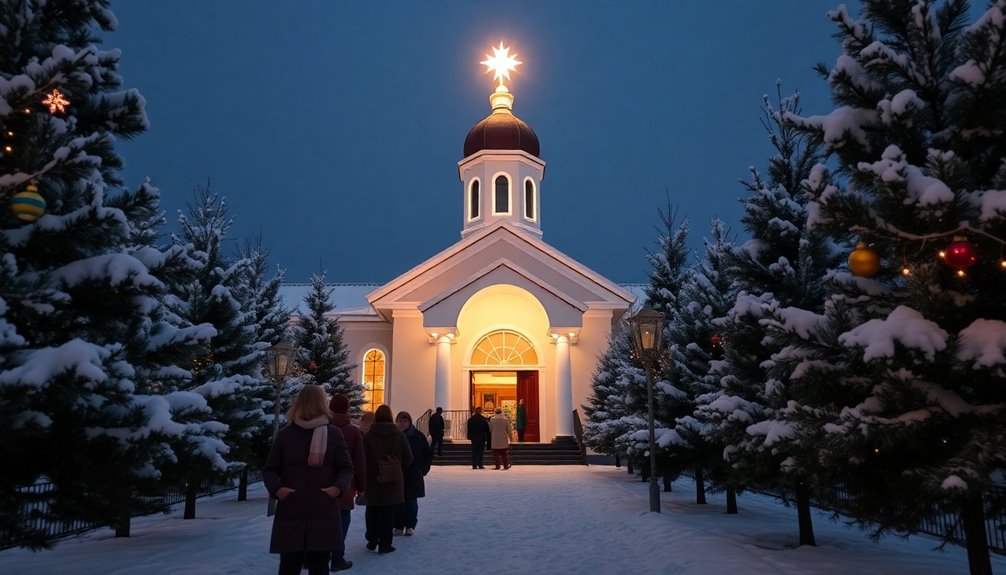
Orthodox Christmas, celebrated on January 7, reflects the unique calendar used by the Orthodox Church, rooted in historical decisions made long ago.
As you explore the traditional observances, you'll discover customs like the festive Christmas Eve meal, which features 12 symbolic dishes.
These practices not only highlight the spiritual significance of the holiday but also showcase the rich cultural variations across different regions.
Calendar Differences Explained
Although many people celebrate Christmas on December 25, the Orthodox Church marks the holiday on January 7 due to its use of the Julian calendar, which is 13 days behind the Gregorian calendar.
This discrepancy originates from the Julian calendar's introduction by Julius Caesar in 45 BC and the inaccuracies that prompted the Gregorian reform in 1582.
Orthodox Christians adhere to the Julian calendar for their religious observances, resulting in their Christmas celebration aligning with January 7, which corresponds to December 25 in the Gregorian system.
While some Orthodox Churches, like those in Greece and Cyprus, have adopted the Revised Julian calendar, others, including the Russian and Egyptian Orthodox Churches, continue to follow the original Julian calendar, preserving their historical traditions.
Traditional Observances and Customs
As January 7 approaches, families prepare for a rich tapestry of traditions that define Orthodox Christmas. The journey begins with a 40-day fasting period, leading to a festive family feast on Christmas Eve, January 6.
You'll likely enjoy twelve traditional dishes, symbolizing Christ's apostles, with Kutia—a special dish of wheat berries, honey, and poppy seeds—representing family unity and the harvest. Each region showcases its unique customs, enhancing cultural identity; for instance, in Greece, some jump into rivers to retrieve a wooden cross during Epiphany.
On January 7, religious services emphasize spiritual reflection through prayer, hymns, and scripture readings, fostering a sense of community and deepening the significance of the holiday.
Unique Traditions and Customs
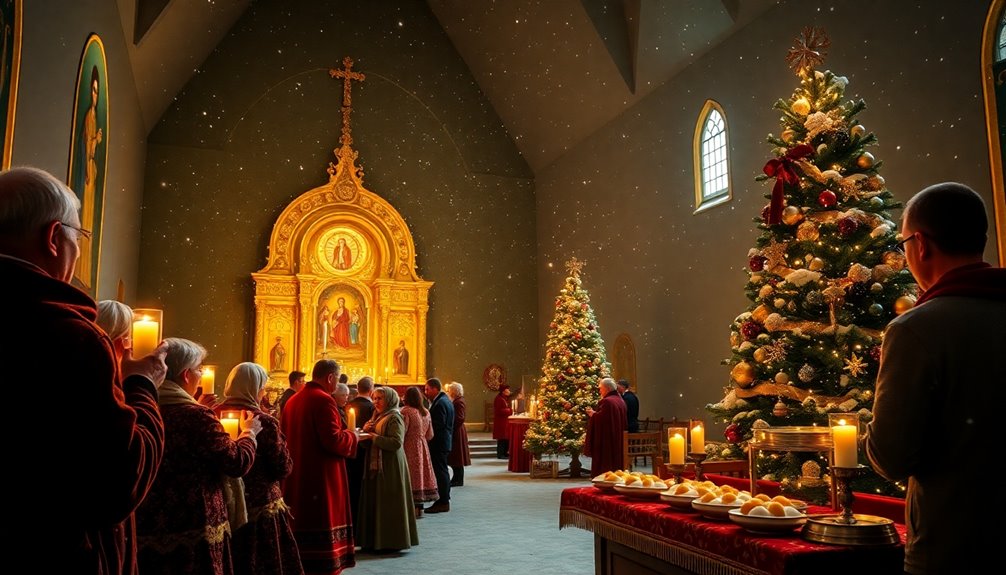
As you explore Orthodox Christmas traditions, you'll notice the importance of fasting and spiritual preparation that leads up to this special day.
Families gather for festive meals, sharing a variety of regional dishes that highlight their unique culinary heritage. Each community adds its own flavor to the celebration, making this holiday a rich tapestry of customs and practices.
Fasting and Spiritual Preparation
In preparation for Christmas, Orthodox Christians engage in a 40-day fasting period known as the Nativity Fast, which begins on November 15. During this time, you'll abstain from meat and dairy products, focusing on spiritual preparation and reflection. This fasting culminates in a special feast on Christmas Eve, January 6, where families gather to share 12 dishes, symbolizing the apostles.
Here's a glimpse into some traditions during the Nativity Fast:
| Day of Fast | Focus | Custom |
|---|---|---|
| November 15 | Start of Fasting | Prayer and Reflection |
| December 25 | Christmas Celebration | Midnight Divine Liturgy |
| December 31 | New Year | Family Gathering |
| January 5 | Eve of Christmas | Special Meal Preparation |
| January 6 | Feast Day | Kutia and Abundance |
These practices strengthen family unity within Orthodox traditions.
Festive Family Gatherings
The culmination of the Nativity Fast leads to joyful festive family gatherings that highlight unique traditions and customs within Orthodox communities.
On Holy Night, families come together for a festive family feast, featuring a traditional meal with twelve dishes that honor the apostles. Kutia, a dish made from wheat berries, honey, and poppy seeds, is often shared, symbolizing family and the harvest.
In places like Ukraine and Russia, homes are decorated with wheat sheaves called didukh, representing unity and abundance. Community gatherings abound, with iconic locations like St. Basil's Cathedral in Moscow serving as vibrant hubs for Orthodox Christmas celebrations.
These customs foster a deep sense of togetherness as families and communities celebrate this sacred season.
Regional Culinary Variations
While celebrating Orthodox Christmas, you'll discover a rich tapestry of regional culinary variations that reflect local traditions and ingredients.
In Ukraine, traditional Christmas Eve meals often feature 12 dishes symbolizing Christ's apostles, with Kutia—a sweet mix of wheat, honey, and poppy seeds—at the center.
The Russian Orthodox Church serves hearty dishes like borscht and roasted meats after midnight services, embodying their festive spirit.
Meanwhile, Coptic Christians in Egypt enjoy lentil soup and stuffed grape leaves, highlighting local flavors.
In Ethiopia, Christmas is celebrated with a fasting meal of injera and spicy vegetarian dishes, emphasizing the importance of fasting before the holiday.
These unique customs showcase the diverse ways Orthodox churches honor Christmas.
Significance of January 6
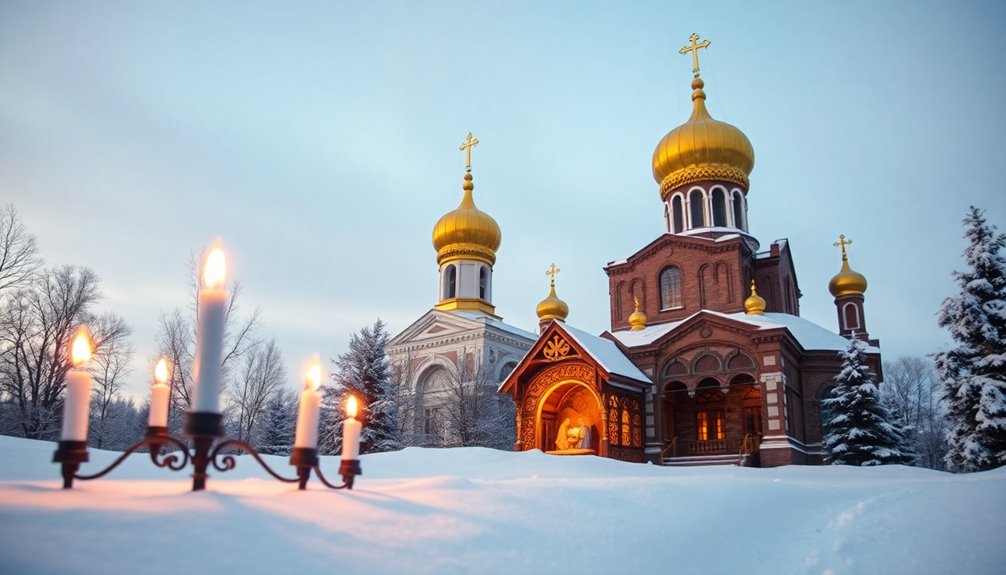
As Orthodox Christians prepare for the joyous celebration of Christmas, January 6 stands out as a significant day of reflection and family unity.
This day, marking the eve of Orthodox Christmas, is known as the Feast of the Nativity, where you gather with loved ones to share special moments.
Religious services emphasize prayer, hymns, and scripture readings, deepening the sense of spiritual preparation before Christ's birth.
Many break their 40-day fasting period with a festive meal that includes 12 traditional dishes, symbolizing Christ's apostles.
This evening fosters themes of repentance and renewal, allowing you to connect with your faith and family as you anticipate the upcoming celebration of Orthodox Christmas on January 7.
Regional Variations in Celebration
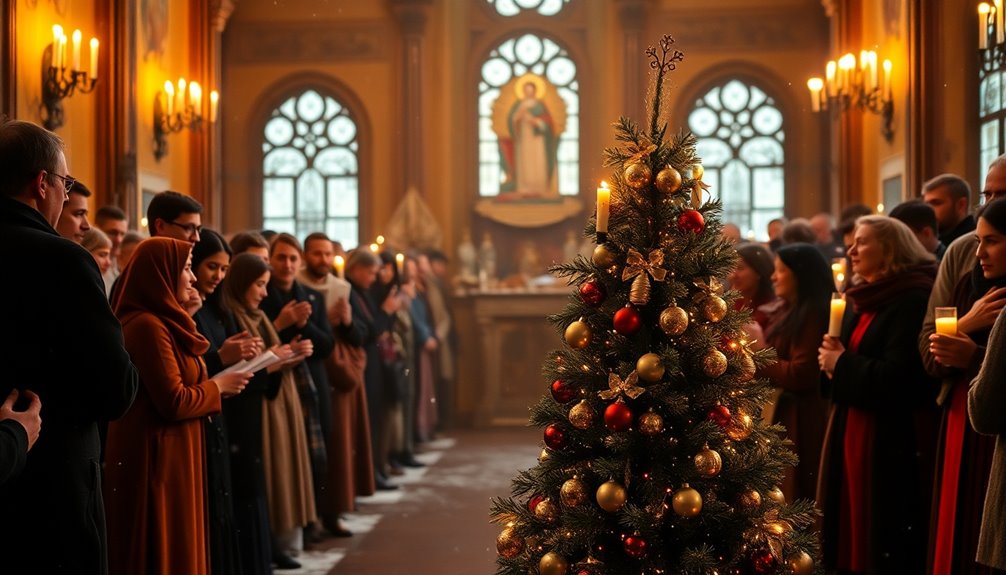
Across the Orthodox Christian world, Christmas celebrations showcase a rich tapestry of regional traditions that reflect local cultures and customs.
In Ukraine, you'll find families celebrating Christmas with traditional dishes like borscht and varenyky, while homes are adorned with wheat sheafs called didukh, symbolizing the harvest.
The Russian Orthodox Church highlights the significance of attending midnight mass on January 6, followed by a feast featuring Kutya, made from wheat, honey, and poppy seeds.
In Ethiopia, you'll see unique customs like wearing white Shamma garments for Genna.
Greek Orthodox communities dive for the cross in the sea, and Romanian families enjoy caroling and a communal feast, all showcasing the diverse ways Orthodox Christians celebrate Christmas while honoring their Christian faith.
Modern Relevance and Cultural Impact
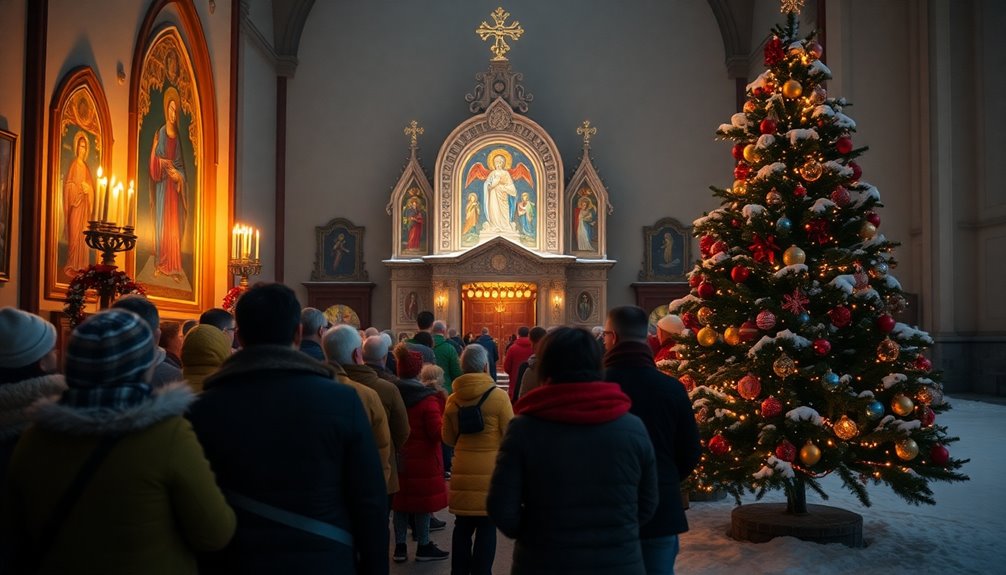
The celebration of Orthodox Christmas on January 7 not only marks a significant religious observance but also highlights the cultural diversity within Christianity.
The calendar differences between the Julian and Gregorian systems foster greater cultural understanding, allowing you to appreciate various holiday practices among different denominations.
Increased media coverage and social media have spotlighted global Orthodox Christmas celebrations, showcasing unique customs that emphasize cultural heritage.
Interfaith dialogues and educational initiatives further enhance awareness of Orthodox traditions, promoting discussions about the importance of religious holidays in today's society.
Ultimately, Orthodox Christmas serves as a reminder of the significance of tradition in maintaining cultural identity, especially in regions with substantial Orthodox populations, enriching the broader tapestry of Christian celebration.
Frequently Asked Questions
Why Do Orthodox Christians Celebrate Christmas on a Different Date?
You might notice that Orthodox Christians celebrate Christmas on a different date due to their use of the Julian calendar.
This calendar lags behind the Gregorian calendar by 13 days, creating a discrepancy in celebration times.
Some Orthodox churches have adopted the Revised Julian calendar and celebrate on December 25, while others stick to the traditional Julian calendar, leading to the January 7 observance.
This difference reflects the rich diversity within Christianity.
Was Jesus Born on the 7th of January?
Imagine trying to catch a shadow—just like the exact date of Jesus' birth remains elusive.
There's no definitive evidence to confirm He was born on January 7. This date, observed by Orthodox Christians, corresponds to December 25 on the Julian calendar.
While traditions vary, most scholars agree the precise day of His birth isn't known. Instead, it's the celebration and its significance that truly matter, uniting millions in faith.
Why Is Russian Christmas on 7 January?
You might wonder why Russian Christmas falls on January 7.
It's mainly because the Russian Orthodox Church follows the Julian calendar, which is 13 days behind the Gregorian calendar most of the world uses.
This difference started after the Great Schism in 1054 when the Orthodox Church chose not to adopt the Gregorian calendar.
As a result, January 7 aligns with December 25 in the Gregorian calendar, marking a unique cultural celebration for its followers.
When Was Christmas Changed From January 6 to December 25?
Christmas was officially changed from January 6 to December 25 in the 4th century AD.
Under Pope Julius I, the Roman Church recognized December 25 as the date of Christ's birth, aligning it with pagan celebrations like the winter solstice.
This shift aimed to counter those pagan customs and standardize the Christian calendar.
The Council of Nicaea in 325 AD further formalized this alteration, marking a significant change in how Christmas was celebrated.
Conclusion
In the dance of calendars, January 7 shines as a beacon for Orthodox Christians, illuminating the unique tapestry of faith and tradition. As you embrace the warmth of this celebration, remember that each custom weaves a thread of history, connecting you to generations past. The joy of Christmas, no matter the date, resonates within your heart, reminding you that love and faith are timeless, echoing like a gentle melody through the ages.
